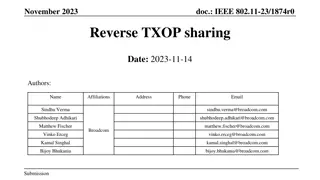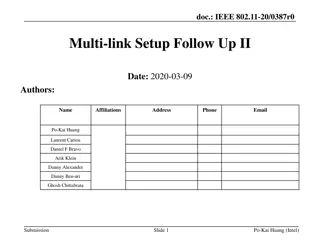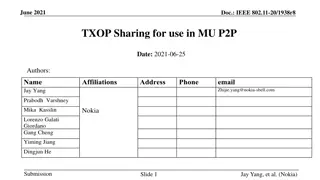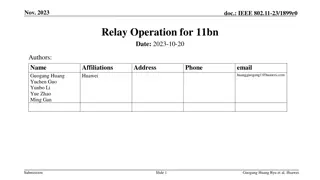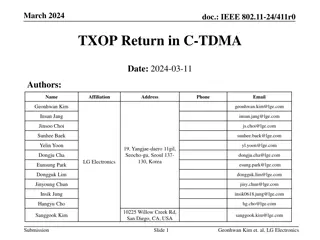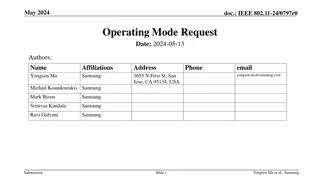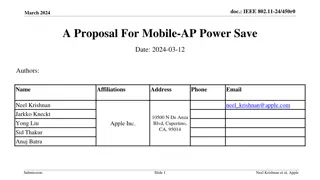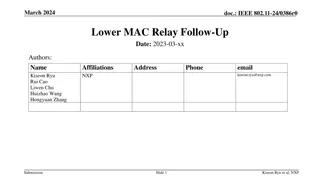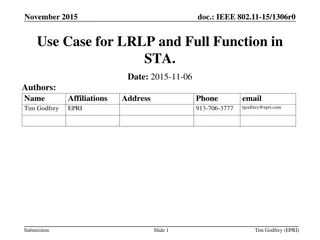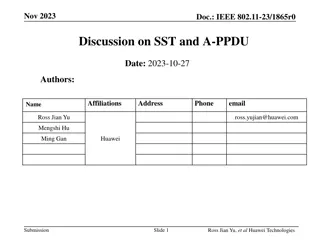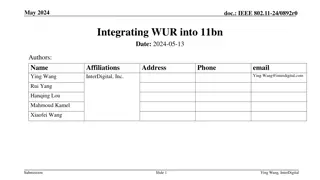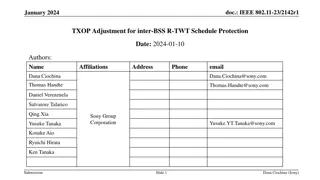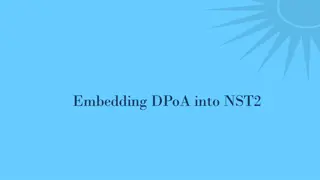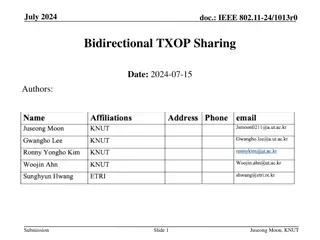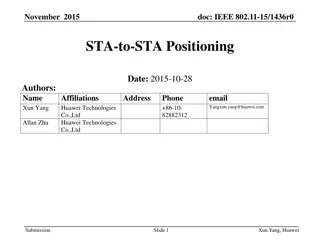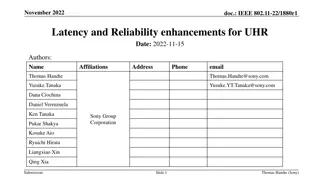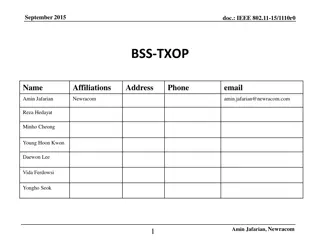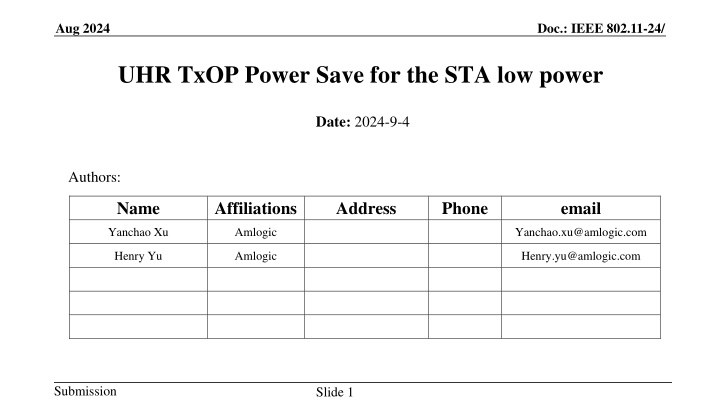
IEEE 802.11-24 UHR TxOP Power Save Mechanisms for Low Power STA
Explore the IEEE 802.11-24 document discussing power save mechanisms for low-power STAs, including VHT TxOP Power Save and 802.11ax Intra-PPDU Power Save. Discover how these mechanisms aim to enhance power efficiency by enabling STAs to enter shallow sleep states during low-traffic scenarios.
Download Presentation

Please find below an Image/Link to download the presentation.
The content on the website is provided AS IS for your information and personal use only. It may not be sold, licensed, or shared on other websites without obtaining consent from the author. If you encounter any issues during the download, it is possible that the publisher has removed the file from their server.
You are allowed to download the files provided on this website for personal or commercial use, subject to the condition that they are used lawfully. All files are the property of their respective owners.
The content on the website is provided AS IS for your information and personal use only. It may not be sold, licensed, or shared on other websites without obtaining consent from the author.
E N D
Presentation Transcript
Aug 2024 Doc.: IEEE 802.11-24/ UHR TxOP Power Save for the STA low power Date: 2024-9-4 Authors: Name Affiliations Address Phone email Yanchao Xu Amlogic Yanchao.xu@amlogic.com Henry Yu Amlogic Henry.yu@amlogic.com Submission Slide 1
Aug 2024 Doc.: IEEE 802.11-24/ Introduction Power save is one important topic that is being discussed in 11bn, and lots of power saving mechanisms have been discussed in the group In [1] (11ax simulation scenario), there was a STA low power mode Shallow Sleep Shallow sleep power state of a wireless module is defined as a sleep state with baseband and MAC processors turned on, but RF is switched off The VHT TxOP Power Save and 802.11ax Intra-PPDU Power Save may make the STA enter the Shallow Sleep For many real use cases of STA, the practical traffic is much more uni- directional , in which there are many more DL traffics than UL traffic. In this contribution, we try to propose the TxOP level Power Save for UHR STAs to make UHR STAs have more chances to enter the shallow sleep state Submission Slide 2
Aug 2024 Doc.: IEEE 802.11-24/ Recap: VHT TxOP Power Save 802.11ac has defined a VHT TxOP Power Save procedure, in which the VHT AP allows non-AP VHT STAs to enter doze state during a TXOP, then a non-AP VHT STA that is in TXOP power save mode may enter the doze state until the end of that TXOP The VHT AP shall include a nav-set sequence (e.g., RTS/CTS) at the beginning of such a TXOP with the Duration/ID value set to the remainder of the TXOP duration. The VHT AP needs send a VHT PPDU with TXOP_PS_NOT_ALLOWED set to 0 in the VHT SIG field STA that receives the VHT PPDU containing no MPDUs of interest can enter the doze state until the end of that TxOP The VHT AP shall not transmit frames to STAs that have been allowed to enter doze state in that TxOP The VHT TxOP Power Save is not used widely in implementations. This mechanism has several problems: The VHT TxOP Powe Save intends to only apply for Intra-BSS TxOP. But 802.11ac does not define procedures to distinguish the Intra-BSS PPDU and Inter-BSS PPDU The VHT PPDU PHY lacks the fields for STA to retrieve the information of TxOP duration, DL/UL, STA AID etc. VHT STA can only get those information from the MPDU level, but sometimes VHT STA may not be able to decode the MPDU, such as a VHT MU PPDU not for itself The VHT TxOP Power Save is not inherited by HE/EHT, and there is not such a TXOP_PS_NOT_ALLOWED field in HE/EHT PPDU Submission Slide 3
Aug 2024 Doc.: IEEE 802.11-24/ Recap: 802.11ax Intra-PPDU Power Save 802.11ax has defined a PPDU level power save mechanism Intra-PPDU Power Save. For a HE STA, a PPDU that is identified as an Intra-BSS PPDU and contains no MPDUs of interest can make this STA enter the doze state until the end of this received PPDU One of the problems for the Intra-PPDU Power Save is that the PPDU must be long enough (in time) to allow a certain HE STA to enter the doze state For a STA, it needs spend some time to enter and exit the doze state. As defined in [1], we assume the STA enters the shallow sleep when entering doze state during the Intra-PPDU Power save. So here we call the doze state here as shallow sleep As defined in [1], the time that STA transits from Receiver to Shallow Sleep (doze state) is TRS, and the time from Shallow Sleep to Listen is TSL The PPDU length must be bigger than the STA s reception process and transit time And for some pure response frame in pre-HE format (e.g. BA in non-HT), STA needs decode the entire PPDU and has no chance to enter shallow sleep Submission Slide 4
Aug 2024 Doc.: IEEE 802.11-24/ Analysis: The state transit time Assuming that the STA enters the shallow sleep during the Intra-BSS PPDU (and the TxOP) Power save, the reference [1] lists some values to show the state transit time, As highlight, the transit time from Receive to SS is TRS = 200us, while the SS to Listen is TSL = 500us, resulting a total transit time of 700us The actual transit time varies hugely depending on the implementation For some of current designs, especially considering the DPS mode can use a RF with lower requirements, the transit time in some of implementations can be lower than the above value. For example, the TRS can be < 100us, and the TSL can be <250us, resulting a total transit time of 350us The larger the transit time is, the longer the corresponding Intra-BSS PPDU should be to make the STA enter the shallow sleep Power Transition parameters State Transitions Transition Time (ms) Average Power Consumption (mW) Transmit Listen TTL=0.01ms 75mW Receive Listen 0.001ms 55mW Listen Transmit TLT = 0.01ms PLT = 100mW Transmit Shallow Sleep TTS=0.01ms PTS = 15mW Receive Shallow Sleep TRS=0.2ms PRS = 15mW Listen Shallow Sleep TLS=0.2ms 0.5 ms (TSL) TLD=1ms TSDL = 10ms PLS = 5mW Shallow Sleep Listen Listen Deep Sleep PDS = 5mW Deep Sleep Listen Submission Slide 5
Aug 2024 Doc.: IEEE 802.11-24/ Analysis: Practical use cases For STA device, e.g. the Phone/Tablet, many of the practical use cases are uni-directional with DL traffic occupying the most time, especially for the long-term use cases. For example, the web browsing, the online video watching etc. Among those use cases, the MSDUs belonging to the traffic stream can be random in both size and arriving time (arrival at the MAC layer). And each of those use cases usually does not have very high average throughput requirement The online video use case, referred as Buffered Video Streaming use case in [1], is one of the use cases that have relatively higher throughout requirement. But as shown in the [1], the actual average throughput is still not high, compared with the current 802.11 MAC/PHY capability For example, a typical peak MAC/PHY capability of Phone is 2x2 (or 1x1) + BW80 + MCS9/11/13, which can introduce bit rate > 400Mbps The BV1 (2Mbps) may correspond to 480p/30fps The BV6 (15.6Mbps) may correspond to 1080p/60fps Submission Slide 6
Aug 2024 Doc.: IEEE 802.11-24/ Analysis: Practical use cases We try to simulate the following use scenarios to find how many PPDUs sent in air can trigger a STA enter the shallow sleep (Intra-BSS PPDU Power Save) By contrast, the corresponding TxOP lasting time is recorded as well The network/BSS under simulation , 4 STAs are associated with AP, and are all running the Buffered Video Stream (online video use case) for 24 seconds The character of the Buffered Video Stream is illustrated in the following slide An observing STA is associated with AP, and record the PPDU/TxOP seen by this Observing STA Only the PPDUs that can amke the Observing STA enter Intra-PPDU Power Save are recorded. For example, the Beacon is not recorded Some other MAC/PHY configurations, Use EHT MCS9/BW80/1x1 constant rate Use MPDU level PER (0/0.05/0.1/0.15) Use SU frame exchange sequence Use AC_BE with default TxOP limit=2528us Submission Slide 7
Aug 2024 Doc.: IEEE 802.11-24/ Analysis: Practical use cases As defined in [2], the characters of the Buffered Video Streaming traffic model, Step 1: The video packet size is generated at constant interval, but with random packet size. At application layer, generate video frame size (bytes) according to Weibull distribution with the following PDF. Step 2: AT TCP layer, set TCP segment as 1500 bytes and fragment video packet into TCP segments. Step 3: Add network latency to TCP/IP packets when these segments arrive at AP for transmission. The network latency is generated according to Gamma distribution whose PDF is shown below Where k=0.2463 theta=60.227 So in the view of AP MAC, the MSDUs are arriving with different/random sizes and different/random frame interval Submission Slide 8
Aug 2024 Doc.: IEEE 802.11-24/ Analysis: Practical use cases The characters of the Buffered Video Streaming traffic model, For two of the STAs, the below figures show the MSDU (TCP segment) size and real time throughput for the BV7 (target video bit rate of 25Mbps) simulation The left figure belongs to STA1, and the right figure belong to STA2. The X Axis is time in second. The Blue Dot is the MSDU (TCP segment) size and the Yellow Line is the real time throughput at different time The figures show the random size of packet size and random arrival time at the AP s MAC layer for both the STA1 and STA2 So the AP has random number of MSDUs with random size to form a PPDU at different time Submission Slide 9
Aug 2024 Doc.: IEEE 802.11-24/ Analysis: Practical use cases To record the histogram of all the PPDUs/TxOPs lasting time, we use different bucket (with different duration definition) to category the PPDUs/TxOPs, based on the their lasting time We use 40 buckets with the time granularity of 50us, and each bucket contains the number of the PPDU/TxOP that has lasting time falling in the bucket. For example, Bucket 1 contains the number of PPDU/TxOP with lasting time <= 50us Bucket 2 contains the number of PPDU/TxOP with lasting time (50us, 100us] Bucket 39 contains the number of PPDU/TxOP with lasting time (1900us, 1950us] Bucket 40 contains the number of PPDU/TxOP with lasting time >1950us Note: for the PPDU duration, we remove the pre-EHT preamble part as the STA needs decode the pre-EHT part to decide if it can enter shallow sleep Right figure shows the histogram of each bucket for the PER=0 As there are a lot of BA and AMPDU with single MPDU, most of the PPDUs have duration < 50us (without pre-EHT part) We show the stats in details in the back up slides Submission Slide 10
Aug 2024 Doc.: IEEE 802.11-24/ Analysis: Practical use cases To have a better view of the stats, we use the CCDF (Complementary Cumulative Distribution Function) plot to illustrate the simulation results The CCDF for a certain value Y shows the probability of X that F(X)= Probability(X>=Y) In this simulation, the CCDF shows the percentage of the PPDU/TxOP with a lasting time that is bigger than a certain duration among all the PPDUs/TxOPs Right figure shows the CCDF of PPDU/TxOP duration distribution for the case of MPDU PER=0 For the PPDU duration distribution (in blue line), Only 3.3% of all the PPDUs have a lasting time larger than 350us Only 1.2% of all the PPDUs have a lasting time larger than 700us So, for the Intra-PPDU power save, If all the transit time is 700us (TRS 200us + TSL 500us), only 1.2% of all the PPDUs can make the Observing STA enter the shallow sleep While, for the TxOP duration distribution (in red line), 37% of all the TxOPs have a lasting time larger than 350us 20% of all the TxOPs have a lasting time larger than 700us So, for the TxOP level power save, If all the transit time is 700us (TRS 200us + TSL 500us), 20% of all the TxOPs can make the Observing STA enter the shallow sleep If the transit time is reduced to 350us, then 37% of all the TxOPs can make Observing STA enter the shallow sleep Submission Slide 11
Aug 2024 Doc.: IEEE 802.11-24/ Analysis: Practical use cases The CCDF plots for the other case with different MPDU PER (0.05/0.1/0.15) They all show the almost the same result as the case with MPDU PER=0 A short conclusion of the simulation is that the STA Intra-BSS PPDU Power Save is quite less likely to be triggered in some practical use cases Assume the STA enters the shallow sleep for the Intra-BSS PPDU Power Save Submission Slide 12
Aug 2024 Doc.: IEEE 802.11-24/ Proposal: Intra-BSS TxOP Power Save for UHR STA To make UHR STA enter the shallow sleep more often, we propose to apply the Intra-BSS TxOP Level power for the UHR STA, with enhancements based on the existing VHT TxOP Power Save Case 1: Allow UHR STA to enter doze state during the AP s SU/MU downlink TxOP. And the same as VHT TxOP PS, AP uses a bit (e.g. TXOP_PS_NOT_ALLOWED) in the UHR PHY U-SIG to indicate whether the TxOP allows TxOP level power save Case 2: Allow UHR STA to enter doze state during the AP s SU/MU triggered uplink TxOP. AP needs use a bit in the Trigger frame (e.g. in the common field or in the Special User Info field) to have the same indication as the TXOP_PS_NOT_ALLOWED in the PHY U-SIG Whether the MU-RTS can trigger the TxOP level power save is TBD Submission Slide 13
Aug 2024 Doc.: IEEE 802.11-24/ Proposal: Intra-BSS TxOP Power Save for UHR STA To enable more flexibility, The same as VHT TxOP PS, AP can control the UHR TxOP PS procedure per each TxOP by introducing the TXOP_PS_NOT_ALLOWED indication in both the UHR PPDU and Trigger frame in non-UHR PPDU Different from VHT TxOP PS, the non-AP UHR STA can dynamically indicate whether it s in UHR TxOP PS mode or not For example, the UHR STA may has the same procedure to enable/disable UHR TxOP PS mode as that of DPS operating mode For example, the UHR STA that has lower latency requirement may request to disable the UHR TxOP PS for a while Coexistence with other power save mechanisms, With HE Intra-PPDU Power Save, The TxOP PS can coexist with Intra-PPDU PS. And it s up to STA s implementation to choose TxOP PS or PPDU PS when a received PPDU satisfies both With UHR DPS, To better coexist with UHR DPS, there may be some requirements for the DPS, Current DPS STA needs to be able to decode upto 24Mbps, and the supported PPDU format is still TBD now. To be able to retrieve the TXOP_DURATION and TXOP_PS_NOT_ALLOW information from the UHR PHY U-SIG, the DPS STA shall at least be able to decode upto the UHR PPDU U-SIG (which is BPSK modulation) Submission Slide 14
Aug 2024 Doc.: IEEE 802.11-24/ Summary In this contribution, we introduce the 802.11ac VHT TxOP Power Save and the 802.11ax Intra-PPDU Power Save, both of which can provide a chance to make the STA enter the shallow sleep (or doze state) We try to analyze the limitation of the VHT TxOP Power Save and use a simulation to show the limitation of the 802.11ax Intra-PPDU Power Save Considering the limitation of the existing 802.11ac/ax mechanisms, we propose to allow an UHR Intra-BSS TxOP level power save for the UHR STA Submission Slide 15
Aug 2024 Doc.: IEEE 802.11-24/ SP 1 Do you support that the UHR AP and UHR STA can support an UHR Intra- BSS TxOP Power Save operating mode, in which the UHR AP can allow an non-AP UHR STAs to enter doze state during a TXOP, then a non-AP UHR STA that is in TXOP power save mode may enter the doze state until the end of that TXOP under some certain conditions? The detailed procedure is TBD The detailed conditions are TBD Submission Slide 16
Aug 2024 Doc.: IEEE 802.11-24/ References [1] 11-14-0980-16-00ax-simulation-scenarios [2] 11-15-0590-02-00ax-traffic-model-updates-to-evaluation-methodology Submission Slide 17
Aug 2024 Doc.: IEEE 802.11-24/ Back Up Submission Slide 18
Aug 2024 Doc.: IEEE 802.11-24/ The detailed stats for the simulation PER=0.05 Duration (us) PPDU Count TxOP Count Bucket 1 50 142589 0 Bucket 2 100 11876 247 Bucket 3 150 3079 2021 Bucket 4 200 2295 11837 Bucket 5 250 798 5980 Bucket 6 300 1704 126 Bucket 7 350 596 1370 Bucket 8 400 1034 1953 Bucket 9 450 569 696 Bucket 10 500 232 96 Bucket 11 550 584 636 PER=0 Bucket 1 Bucket 2 Bucket 3 Bucket 4 Bucket 5 Bucket 6 Bucket 7 Bucket 8 Bucket 9 Bucket 10 Bucket 11 PER=0.1 Bucket 1 Bucket 2 Bucket 3 Bucket 4 Bucket 5 Bucket 6 Bucket 7 Bucket 8 Bucket 9 Bucket 10 Bucket 11 PER=0.15 Duration (us) Bucket 1 Bucket 2 Bucket 3 Bucket 4 Bucket 5 Bucket 6 Bucket 7 Bucket 8 Bucket 9 Bucket 10 Bucket 11 Duration (us) PPDU Count TxOP Count Duration (us) PPDU Count TxOP Count PPDU Count TxOP Count 50 100 150 200 250 300 350 400 450 500 550 143400 11779 2891 2305 789 1610 595 995 599 238 587 0 50 100 150 200 250 300 350 400 450 500 550 141404 11903 3296 2372 835 1769 556 1089 568 272 615 0 50 100 150 200 250 300 350 400 450 500 550 140739 11864 3560 2450 834 1847 597 1106 579 234 566 0 248 2002 11892 6160 125 1323 2041 765 90 702 212 2045 11733 5918 149 1302 1956 703 83 625 246 2036 11631 5891 113 1304 1889 719 75 634 Bucket 12 Bucket 13 Bucket 14 Bucket 15 Bucket 16 Bucket 17 Bucket 18 Bucket 19 Bucket 20 Bucket 21 Bucket 22 600 650 700 750 800 850 900 950 1000 1050 1100 186 311 388 136 277 182 77 180 70 103 76 347 240 130 456 176 138 216 173 166 103 178 Bucket 12 Bucket 13 Bucket 14 Bucket 15 Bucket 16 Bucket 17 Bucket 18 Bucket 19 Bucket 20 Bucket 21 Bucket 22 600 650 700 750 800 850 900 950 1000 1050 1100 212 300 369 123 280 182 84 186 64 92 87 371 222 128 459 172 166 227 196 184 108 171 Bucket 12 Bucket 13 Bucket 14 Bucket 15 Bucket 16 Bucket 17 Bucket 18 Bucket 19 Bucket 20 Bucket 21 Bucket 22 600 650 700 750 800 850 900 950 1000 1050 1100 183 330 396 123 278 181 80 193 60 93 79 353 242 119 410 184 162 199 193 166 104 162 Bucket 12 Bucket 13 Bucket 14 Bucket 15 Bucket 16 Bucket 17 Bucket 18 Bucket 19 Bucket 20 Bucket 21 Bucket 22 600 650 700 750 800 850 900 950 1000 1050 1100 213 344 405 125 283 177 76 197 72 90 75 308 242 117 429 182 161 194 165 151 103 160 Bucket 23 Bucket 24 Bucket 25 Bucket 26 Bucket 27 Bucket 28 Bucket 29 Bucket 30 Bucket 31 Bucket 32 Bucket 33 Bucket 34 Bucket 35 Bucket 36 Bucket 37 Bucket 38 Bucket 39 Bucket 40 1150 1200 1250 1300 1350 1400 1450 1500 1550 1600 1650 1700 1750 1800 1850 1900 1950 2000 77 95 23 184 30 2 3 23 0 20 1 2 25 1 19 2 0 74 168355 107 132 99 146 80 116 90 91 100 84 65 63 76 86 78 79 79 3230 32472 Bucket 23 Bucket 24 Bucket 25 Bucket 26 Bucket 27 Bucket 28 Bucket 29 Bucket 30 Bucket 31 Bucket 32 Bucket 33 Bucket 34 Bucket 35 Bucket 36 Bucket 37 Bucket 38 Bucket 39 Bucket 40 1150 1200 1250 1300 1350 1400 1450 1500 1550 1600 1650 1700 1750 1800 1850 1900 1950 2000 79 105 39 183 25 5 1 23 3 28 0 1 22 1 11 2 1 87 167951 116 127 102 145 83 125 82 71 92 85 87 72 67 72 86 61 80 3298 32217 Bucket 23 Bucket 24 Bucket 25 Bucket 26 Bucket 27 Bucket 28 Bucket 29 Bucket 30 Bucket 31 Bucket 32 Bucket 33 Bucket 34 Bucket 35 Bucket 36 Bucket 37 Bucket 38 Bucket 39 Bucket 40 1150 1200 1250 1300 1350 1400 1450 1500 1550 1600 1650 1700 1750 1800 1850 1900 1950 2000 68 91 29 208 29 3 5 28 2 29 2 2 21 2 9 0 2 88 101 132 81 124 73 116 88 86 66 95 80 75 91 83 90 56 76 3402 31935 Bucket 23 Bucket 24 Bucket 25 Bucket 26 Bucket 27 Bucket 28 Bucket 29 Bucket 30 Bucket 31 Bucket 32 Bucket 33 Bucket 34 Bucket 35 Bucket 36 Bucket 37 Bucket 38 Bucket 39 Bucket 40 1150 1200 1250 1300 1350 1400 1450 1500 1550 1600 1650 1700 1750 1800 1850 1900 1950 2000 80 93 29 205 30 2 2 24 2 17 2 1 21 1 12 0 2 80 111 137 92 144 73 109 94 103 95 79 69 73 59 72 85 57 73 3461 31736 167293 167036 Submission Slide 19

